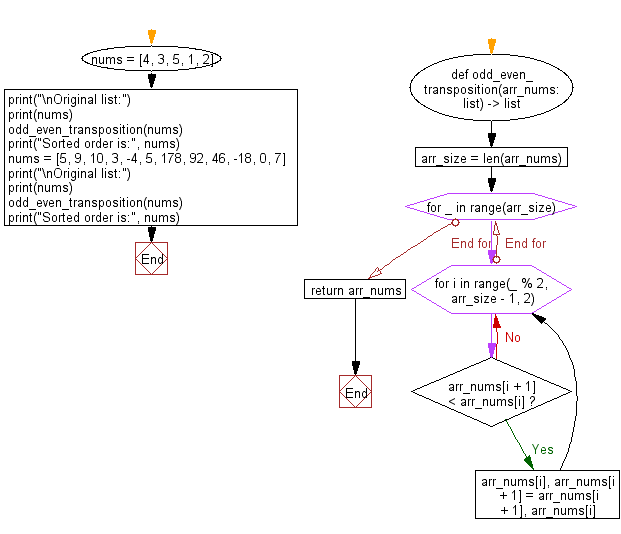Python: Sort unsorted numbers using non-parallelized implementation of odd-even transposition sort
36. Non-Parallel Odd-Even Sort
Write a Python program to sort unsorted numbers using non-parallelized implementation of odd-even transposition sort.
From Wikipedia:
In computing, an odd-even sort or odd-even transposition sort (also known as brick sort or parity sort) is a relatively simple sorting algorithm, developed originally for use on parallel processors with local interconnections. It is a comparison sort related to bubble sort, with which it shares many characteristics. It functions by comparing all odd/even indexed pairs of adjacent elements in the list and, if a pair is in the wrong order (the first is larger than the second) the elements are switched. The next step repeats this for even/odd indexed pairs (of adjacent elements). Then it alternates between odd/even and even/odd steps until the list is sorted.
Sample Solution:
Python Code:
def odd_even_transposition(arr_nums: list) -> list:
arr_size = len(arr_nums)
for _ in range(arr_size):
for i in range(_ % 2, arr_size - 1, 2):
if arr_nums[i + 1] < arr_nums[i]:
arr_nums[i], arr_nums[i + 1] = arr_nums[i + 1], arr_nums[i]
return arr_nums
nums = [4, 3, 5, 1, 2]
print("\nOriginal list:")
print(nums)
odd_even_transposition(nums)
print("Sorted order is:", nums)
nums = [5, 9, 10, 3, -4, 5, 178, 92, 46, -18, 0, 7]
print("\nOriginal list:")
print(nums)
odd_even_transposition(nums)
print("Sorted order is:", nums)
Sample Output:
Original list: [4, 3, 5, 1, 2] Sorted order is: [1, 2, 3, 4, 5] Original list: [5, 9, 10, 3, -4, 5, 178, 92, 46, -18, 0, 7] Sorted order is: [-18, -4, 0, 3, 5, 5, 7, 9, 10, 46, 92, 178]
Flowchart:

For more Practice: Solve these Related Problems:
- Write a Python program to implement a non-parallelized version of odd-even transposition sort and output the sorted list.
- Write a Python script to simulate non-parallel odd-even sort and print the list after every complete pass.
- Write a Python program to compare non-parallelized odd-even sort with its parallel counterpart by counting the number of swaps.
- Write a Python function to implement non-parallel odd-even sort and then validate the sort by comparing with Python’s built-in sort.
Go to:
Previous: Write a Python program to sort an odd–even sort or odd–even transposition sort.
Next: Write a Python program to sort unsorted numbers using Odd Even Transposition Parallel sort.
Python Code Editor:
Contribute your code and comments through Disqus.
What is the difficulty level of this exercise?
Test your Programming skills with w3resource's quiz.
